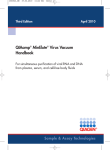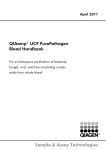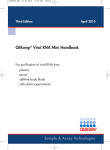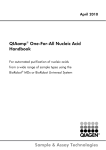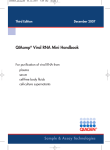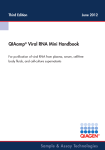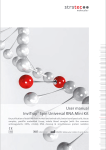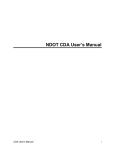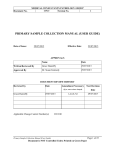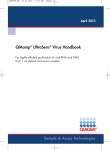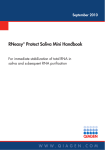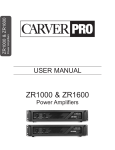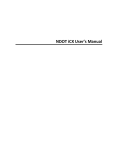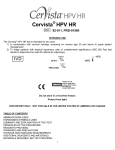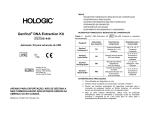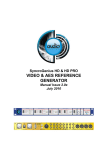Download QIAamp MinElute Media Handbook
Transcript
April 2010 QIAamp® MinElute™ Media Handbook For purification of nucleic acids from liquid media using vacuum systems WWW.QIAGEN.COM Trademarks: QIAGEN®, QIAamp®, MinElute™ (QIAGEN Group); PreservCyt® (Cytyc Corporation); SurePath™ (TriPath Imaging, Inc.); Tween® (ICI Americas Inc.). The PCR process is covered by U.S. Patents 4,683,195 and 4,683,202 and foreign equivalents owned by Hoffmann-La Roche AG. © 2004 QIAGEN, all rights reserved. Contents Kit Contents 4 Storage 4 Quality Control 5 Product Use Limitations 5 Product Warranty and Satisfaction Guarantee 5 Technical Assistance 6 Safety Information 6 Introduction 8 Principle and procedure 8 Equipment and Reagents to Be Supplied by User 11 Important Notes 12 Elution of pure nucleic acids 12 Yield and size of nucleic acids 12 Carrier RNA 12 Addition of internal controls 13 Handling of QIAamp MinElute columns 13 Preparation of buffers 15 Protocol Purification of Nucleic Acids from Media 17 Troubleshooting Guide 20 Appendix A: Handling Guidelines for the QIAvac 24 24 Appendix B: Handling Guidelines for the QIAvac 24 Plus 28 Appendix C: Cleaning and Decontaminating the Vacuum Manifold 30 References 31 Ordering Information 32 QIAamp MinElute Media Handbook 04/2010 3 Kit Contents QIAamp MinElute Media Kit (50) Catalog no. 1025106 Number of preps 50 QIAamp MinElute Columns (each packaged with a 2 ml Collection Tube) 50 Extension Tubes (3 ml) 50 Collection Tubes (1.5 ml) 50 VacConnectors 50 Buffer ATL 10 ml Buffer AL* 33 ml Buffer AW2† (concentrate) 13 ml Buffer AVE† (tubes with purple caps) 4 x 2 ml Carrier RNA (tube with red cap) 310 μg QIAGEN Proteinase K 1.25 ml Handbook 1 * Contains a guanidine salt. Not compatible with disinfectants containing bleach. See page 6 for safety information. † Contains sodium azide as a preservative. Storage QIAamp MinElute columns should be stored at 2–8ºC upon arrival. Short-term storage of up to 4 weeks at room temperature (15–25ºC) does not affect performance. QIAGEN proteinase K solution can be stored at room temperature (15–25ºC) for up to one year after delivery. For longer storage or if ambient temperatures exceed 25ºC, we suggest storing QIAGEN proteinase K at 2–8ºC. All buffers can be stored at room temperature (15–25ºC). 4 QIAamp MinElute Media Handbook 04/2010 Lyophilized carrier RNA is stable for up to 1 year when stored at room temperature (15–25ºC). Carrier RNA can only be dissolved in Buffer AVE or an internal control (if used); dissolved carrier RNA should be immediately added to Buffer AL as described in “Addition of carrier RNA to Buffer AL” on page 15. This solution should be prepared fresh, and is stable at 2–8ºC for up to 48 hours. Unused portions of Buffer AVE-dissolved carrier RNA should be frozen in aliquots at –20ºC. Quality Control As part of the stringent QIAGEN quality assurance program, the performance of QIAamp MinElute Media Kits is monitored routinely on a lot-to-lot basis. All components are tested separately to ensure highest performance and reliability. Product Use Limitations The QIAamp MinElute Media Kit is intended for molecular biology applications. This product is not intended for the diagnosis, prevention, or treatment of disease. All due care and attention should be exercised in the handling of the products. We recommend all users of QIAGEN products to adhere to the NIH guidelines that have been developed for recombinant DNA experiments, or to other applicable guidelines. Product Warranty and Satisfaction Guarantee QIAGEN guarantees the performance of all products in the manner described in our product literature. The purchaser must determine the suitability of the product for its particular use. Should any product fail to perform satisfactorily due to any reason other than misuse, QIAGEN will replace it free of charge or refund the purchase price. We reserve the right to change, alter, or modify any product to enhance its performance and design. If a QIAGEN product does not meet your expectations, simply call your local Technical Service Department or distributor. We will credit your account or exchange the product — as you wish. A copy of QIAGEN terms and conditions can be obtained on request, and is also provided on the back of our invoices. If you have questions about product specifications or performance, please call QIAGEN Technical Services or your local distributor (see back cover). QIAamp MinElute Media Handbook 04/2010 5 Technical Assistance At QIAGEN we pride ourselves on the quality and availability of our technical support. Our Technical Service Departments are staffed by experienced scientists with extensive practical and theoretical expertise in molecular biology and the use of QIAGEN products. If you have any questions or experience any difficulties regarding the QIAamp MinElute Media Kit or QIAGEN products in general, please do not hesitate to contact us. QIAGEN customers are a major source of information regarding advanced or specialized uses of our products. This information is helpful to other scientists as well as to the researchers at QIAGEN. We therefore encourage you to contact us if you have any suggestions about product performance or new applications and techniques. For technical assistance and more information please call one of the QIAGEN Technical Service Departments or local distributors (see back cover). Safety Information When working with chemicals, always wear a suitable lab coat, disposable gloves, and protective goggles. For more information, please consult the appropriate material safety data sheets (MSDSs). These are available online in convenient and compact PDF format at www.qiagen.com/ts/msds.asp where you can find, view, and print the MSDS for each QIAGEN kit and kit component. CAUTION: DO NOT add bleach or acidic solutions directly to waste containing Buffer AL. Buffer AL contains guanidine hydrochloride, which can form highly reactive compounds when combined with bleach. If liquid containing this buffer is spilt, clean with suitable laboratory detergent and water. If the spilt liquid contains potentially infectious agents, clean the affected area first with laboratory detergent and water, and then with 1% (v/v) sodium hypochlorite. 6 QIAamp MinElute Media Handbook 04/2010 The following risk and safety phrases apply to components of the QIAamp MinElute Media Kit. Buffer AL Contains guanidine hydrochloride: harmful, irritant. Risk and safety phrases:* R22-36/38, S13-26-36-46 QIAGEN proteinase K Contains proteinase K: sensitizer, irritant. Risk and safety phrases:* R36/37/38-42/43, S23-24-26-36/37 24-hour emergency information Emergency medical information in English, French, and German can be obtained 24 hours a day from: Poison Information Center Mainz, Germany Tel: +49-6131-19240 * R22: Harmful if swallowed; R36/38: Irritating to eyes and skin; R36/37/38: Irritating to eyes, respiratory system, and skin; R42/43: May cause sensitization by inhalation and skin contact; S13: Keep away from food, drink and animal feeding stuffs; S23: Do not breathe spray; S24: Avoid contact with skin; S26: In case of contact with eyes, rinse immediately with plenty of water and seek medical advice; S36: Wear suitable protective clothing; S36/37: Wear suitable protective clothing and gloves; S46: If swallowed, seek medical advice immediately and show this container or label. QIAamp MinElute Media Handbook 04/2010 7 Introduction The QIAamp MinElute Media Kit uses well-established technology for purification of nucleic acids. The kit combines the selective binding properties of a silica-based membrane with flexible elution volumes of between 20 and 150 μl. The kit is suitable for use with liquid media containing nucleic acids, such as cervical swab transport media (e.g., PreservCyt® or SurePath™ solution). Nucleic acids are eluted in Buffer AVE, ready for use in amplification reactions or storage at –20ºC. Purified nucleic acids are free of proteins, nucleases, and other impurities. Principle and procedure The QIAamp MinElute Media procedure has 4 steps (lyse, bind, wash, elute; see flowchart, page 10) and uses QIAamp MinElute columns on a vacuum manifold. The procedure is designed to ensure that there is no sample-tosample cross-contamination and allow safe handling of potentially infectious samples. The simple QIAamp MinElute Media procedure is highly suited for simultaneous processing of multiple samples, and yields pure nucleic acids from 24 samples in less than 90 minutes. The QIAamp MinElute Media procedure can be used for isolation of genomic DNA and viral nucleic acids from a broad range of viruses. However, performance cannot be guaranteed for every virus species and must be validated by the user. Sample volumes Each QIAamp MinElute column can bind nucleic acids that are longer than 200 bases, but yield depends on sample volume and nucleic acid content. The procedure is optimized for use with a starting volume of 250 μl. Lysis with QIAGEN proteinase K Samples are lysed under denaturing conditions at elevated temperatures. Lysis is performed in the presence of QIAGEN proteinase K and Buffer ATL. Addition of Buffer AL enhances lysis efficiency and ensures inactivation of RNases. Adsorption to the QIAamp MinElute column membrane Binding conditions are adjusted by adding ethanol to the lysates to ensure optimal binding of nucleic acids to the QIAamp MinElute column membrane. Lysate is applied to a QIAamp MinElute column and nucleic acids are adsorbed onto the silica-gel membrane as the lysate is drawn through by vacuum pressure. Salt and pH conditions ensure that protein and other contaminants, which can inhibit PCR and other downstream enzymatic reactions, are not retained on the membrane. 8 QIAamp MinElute Media Handbook 04/2010 A vacuum manifold and a vacuum source or pump capable of producing a vacuum of –800 to –900 mbar are required for the procedure. A vacuum regulator should be used for easy monitoring of vacuum pressures and convenient vacuum release. For details, see “Equipment and Reagents to Be Supplied by User”, page 11. Removal of residual contaminants Nucleic acids remain bound to the QIAamp MinElute column membrane, while contaminants are efficiently washed away during a sequence of wash steps using 2 different wash solutions. In a single step, highly pure nucleic acids are eluted in Buffer AVE equilibrated to room temperature (15–25ºC). QIAamp MinElute Media Handbook 04/2010 9 10 QIAamp MinElute Media Handbook 04/2010 Equipment and Reagents to Be Supplied by User When working with chemicals, always wear a suitable lab coat, disposable gloves, and protective goggles. For more information, consult the appropriate material safety data sheets (MSDSs), available from the product supplier. Ethanol (96–100%) 2 ml microcentrifuge tubes Pipet tips (pipet tips with aerosol barriers for preventing crosscontamination are recommended) Disposable gloves Heating block, thermomixer, or heated orbital incubator for lysis of samples: one for 56ºC incubation and another for 70ºC incubation Microcentrifuge Vortexer Vacuum manifold (e.g., QIAvac 24, cat. no. 19403, or QIAvac 24 Plus,* cat. no. 19413) Vacuum pump with a capacity of 34 liter/min and capable of producing a vacuum of –800 to –900 mbar (e.g., Vacuum Pump,* cat. no. 84000,† 84010,‡ or 84020§) If using the QIAvac 24 Vacuum Regulator (cat. no. 19530) — for easy monitoring of vacuum pressures and easy release of vacuum If using the QIAvac 24 Plus QIAvac Connecting System* (cat. no. 19419) — for connection of the QIAvac 24 Plus with the Vacuum Pump (cat. no. 84000,† 84010,‡ or 84020§) If using the QIAvac 24 or QIAvac 24 Plus Optional: QIAamp Vac Accessory Set (cat. no. 19409) — contains 12 VacValves, for vacuum regulation of each individual column if sample flow rates differ significantly, and 500 VacConnectors, for prevention of cross-contamination caused by direct contact between QIAamp MinElute column and QIAvac 24 or QIAvac 24 Plus * Available by mid-2004; please check www.qiagen.com/products/accessories † Japan (110 V, 60 Hz) ‡ Canada and USA (115 V, 60 Hz) § Australia and Europe (230 V, 50 Hz) QIAamp MinElute Media Handbook 04/2010 11 Important Notes Elution of pure nucleic acids DNA is eluted into Buffer AVE. QIAamp MinElute columns allow minimal elution volumes of only 20 μl. Low elution volume leads to highly concentrated nucleic acid eluates. For downstream applications that require small starting volumes (e.g., some PCR and RT-PCR assays), a more concentrated eluate may increase assay sensitivity. For downstream applications that require a larger starting volume, elution volume can be increased up to 150 μl. However, an increase in elution volume will decrease the concentration of nucleic acids in the eluate. The volume of eluate recovered can be up to 5 μl less than the volume of elution buffer applied to the column; for example, an elution buffer volume of 20 μl results in >15 μl final eluate. The volume of eluate recovered also depends on the nature of the sample. Eluted nucleic acids are collected in 1.5 ml collection tubes (provided). If the purified nucleic acids are to be stored for up to 24 hours, storage at 2–8ºC is recommended. To store nucleic acids for longer than 24 hours, storage at –20ºC is recommended. Yield and size of nucleic acids Yields of nucleic acids isolated from liquid media are normally below 1 μg and are therefore difficult to determine with a spectrophotometer. Quantitative amplification methods are recommended for determination of yields. When quantifying nucleic acids isolated using the QIAamp MinElute Media procedure, remember that there will be much more carrier RNA in the sample than target nucleic acids. The size distribution of nucleic acids purified using this procedure can be checked by agarose gel electrophoresis and hybridization to a target-specific labeled probe followed by autoradiography (Sambrook, J., Fritsch, E.F., Maniatis, T. [1989] Molecular Cloning: A Laboratory Manual, 2nd ed. Cold Spring Harbor, NY: Cold Spring Harbor Laboratory Press). Carrier RNA Carrier RNA enhances binding of nucleic acids to the QIAamp MinElute column membrane, especially if there are very few target molecules in the sample. If carrier RNA is not added to Buffer AL, this may lead to reduced nucleic acid recovery. 12 QIAamp MinElute Media Handbook 04/2010 The amount of lyophilized carrier RNA provided is sufficient for the volume of Buffer AL supplied with the kit. The concentration of carrier RNA has been adjusted so that the QIAamp MinElute Media procedure can be used as a universal purification system compatible with many different amplification systems and is suitable for a wide range of samples. Different amplification systems vary in efficiency depending on the total amount of nucleic acids present in the reaction. Eluates from this kit contain both target nucleic acids and carrier RNA, and amounts of carrier RNA will greatly exceed amounts of target nucleic acids. The amount of eluate to add to downstream amplifications should therefore be based on the amount of carrier RNA added. To obtain the highest levels of sensitivity in amplification reactions, it may be necessary to adjust the amount of carrier RNA added to Buffer AL. Addition of internal controls Using the QIAamp MinElute Media procedure in combination with commercially available amplification systems may require the introduction of an internal control into the procedure. An internal control should be added together with the carrier RNA to Buffer AL. For optimal purification efficiency, internal control molecules should be longer than 200 nucleotides, as smaller molecules are not efficiently recovered. Refer to the manufacturer’s instructions in order to determine the optimal concentration of internal control. Using a concentration other than that recommended may reduce amplification efficiency. Handling of QIAamp MinElute columns Because of the sensitivity of nucleic acid amplification technologies, the following precautions are necessary when handling QIAamp MinElute columns in order to avoid cross-contamination between sample preparations: Carefully pipet the sample or solution into the QIAamp MinElute column without wetting the rim of the column. Avoid touching the QIAamp MinElute column membrane with the pipet tip. Change pipet tips between all liquid transfers. The use of aerosol-barrier pipet tips is recommended. After all pulse-vortexing steps, briefly centrifuge tubes to remove drops from the inside of the lid. Wear gloves throughout the entire procedure. In case of contact between gloves and sample, change gloves immediately. QIAamp MinElute Media Handbook 04/2010 13 Processing QIAamp MinElute columns on QIAvac 24 or QIAvac 24 Plus QIAamp MinElute columns are processed on the QIAvac 24 or QIAvac 24 Plus vacuum manifold using disposable VacConnectors and reusable VacValves (use of VacValves is optional). VacValves are inserted directly into the luer extensions/slots of the vacuum manifold, and ensure a steady flow rate, facilitating parallel processing of samples of different nature, volume, or viscosity. If sample flow rates differ significantly, VacValves must be used to ensure consistent vacuum. VacConnectors are disposable connectors that fit between the QIAamp MinElute columns and the VacValves, or between the QIAamp MinElute columns and the luer extensions/slots of the vacuum manifold. VacConnectors prevent direct contact between the QIAamp MinElute columns and the VacValves or the vacuum manifold during purification, avoiding any cross-contamination between samples. VacConnectors are discarded after a single use. Handling guidelines for vacuum manifold If using the QIAvac 24 or QIAvac 24 Plus, refer to the handling guidelines in Appendix A (page 24) or Appendix B (page 28), respectively. In addition, refer to Appendix C (page 30) for guidelines on cleaning and decontaminating the QIAvac 24 or QIAvac 24 Plus after processing QIAamp MinElute columns. If using another vacuum manifold, refer to the manufacturer’s guidelines for handling, cleaning, and decontamination. Centrifugation For the dry spin at the end of the wash steps of the procedure and for elution, centrifugation should be carried out at full speed. All centrifugation steps should be carried out at room temperature (15–25ºC). Processing QIAamp MinElute columns in a microcentrifuge Close the QIAamp MinElute column before placing it in the microcentrifuge. Centrifuge as described. Remove the QIAamp MinElute column and collection tube from the microcentrifuge. Discard the filtrate and the used 2 ml collection tube. Place the QIAamp MinElute column in the 1.5 ml collection tube. Open only one QIAamp MinElute column at a time, and take care to avoid generating aerosols. 14 QIAamp MinElute Media Handbook 04/2010 Preparation of buffers Addition of carrier RNA to Buffer AL Add 310 μl Buffer AVE to the tube containing 310 μg lyophilized carrier RNA to obtain a solution of 1 μg/μl. Dissolve the carrier RNA thoroughly, divide it into conveniently sized aliquots, and store at –20ºC. Do not freeze–thaw the aliquots of carrier RNA more than 3 times. Note that carrier RNA does not dissolve in Buffer AL. It must first be dissolved in Buffer AVE and then added to Buffer AL. Calculate the volume of Buffer AL/carrier RNA mix needed per batch of samples by selecting the number of samples to be simultaneously processed from Table 1 (page 15). For larger numbers of samples, volumes can be calculated using the following sample calculation: n x 0.3 ml = y ml y ml x 10 μl/ml = z μl where: n = number of samples to be processed simultaneously y = calculated volume of Buffer AL z = volume of carrier RNA/Buffer AVE to add to Buffer AL Gently mix by inverting the tube 10 times. To avoid foaming, do not vortex. Table 1. Volumes of Buffer AL and Carrier RNA/Buffer AVE Mix Required for the QIAamp MinElute Media Procedure No. samples Vol. Buffer AL (ml) Vol. Carrier RNA/AVE (μl) 1 0.3 3 2 0.6 6 3 0.9 9 4 1.2 12 5 1.5 15 6 1.8 18 7 2.1 21 8 2.4 24 9 2.7 27 10 3.0 30 QIAamp MinElute Media Handbook 04/2010 15 Table 1. Continued No. samples Vol. Buffer AL (ml) Vol. Carrier RNA/AVE (μl) 11 3.3 33 12 3.6 36 13 3.9 39 14 4.2 42 15 4.5 45 16 4.8 48 17 5.1 51 18 5.4 54 19 5.7 57 20 6.0 60 21 6.3 63 22 6.6 66 23 6.9 69 24 7.2 72 Note: The sample preparation procedure is optimized for 2.5 μg of carrier RNA per sample. If less carrier RNA has been shown to be better for your amplification system, transfer only the required amount of dissolved carrier RNA to the tubes containing Buffer AL. For each microgram of carrier RNA required per preparation, add 4 μl Buffer AVE-dissolved carrier RNA per milliliter of Buffer AL. (Use of less than 2.5 μg carrier RNA per sample must be validated for each particular sample type and downstream assay.) Buffer AW2 Add 30 ml of ethanol (96–100%) to a bottle containing 13 ml of Buffer AW2 concentrate, as described on the bottle. Tick the check box on the label to indicate that ethanol has been added. Store reconstituted Buffer AW2 at room temperature (15–25ºC). Reconstituted Buffer AW2 is stable for 1 year when stored at room temperature. Note: Always mix reconstituted Buffer AW2 by shaking before starting the procedure. 16 QIAamp MinElute Media Handbook 04/2010 Protocol: Purification of Nucleic Acids from Media For isolation of nucleic acids from 250 μl of liquid media such as cervical swab transport media (e.g., PreservCyt or SurePath solution). Important points before starting All centrifugation steps are carried out at room temperature (15–25ºC). After applying lysate or wash solution to the QIAamp MinElute column in steps 12, 13, and 14, wait for at least 1 minute before switching on the vacuum pump. After all liquid has been drawn through the column, wait for at least one minute before switching the vacuum pump off and releasing the vacuum. Things to do before starting Equilibrate samples to room temperature (15–25ºC). Equilibrate Buffer AVE to room temperature for elution in step 18. If a precipitate has formed in Buffer ATL or AL, dissolve by heating to 70ºC and gentle agitation. Prepare a 56ºC heating block, thermomixer, or heated orbital incubator for use in step 4, and a 70ºC heating block, thermomixer, or heated orbital incubator for use in step 7. Ensure that Buffer AW2 has been prepared according to instructions on page 16. Add carrier RNA dissolved in Buffer AVE to Buffer AL according to instructions on page 15. Procedure 1. Pipet 80 μl of Buffer ATL into a 2 ml microcentrifuge tube (not provided). 2. Add 250 μl of sample into the 2 ml microcentrifuge tube. 3. Add 20 μl QIAGEN proteinase K. Close the lid and mix by pulse-vortexing for 10 s. 4. Incubate at 56ºC for 30 min. Shake the samples to ensure high nucleic acid yields. For optimal results, use a thermomixer at 900 rpm. If using a heating block, vortex the samples occasionally throughout the incubation period. 5. Briefly centrifuge the 2 ml tube to remove drops from the inside of the lid. QIAamp MinElute Media Handbook 04/2010 17 6. Add 250 μl of Buffer AL (containing 10 μg/ml of carrier RNA). Close the lid and mix by pulse-vortexing for 10 s. To ensure efficient lysis, it is essential that the sample, Buffer ATL, QIAGEN proteinase K, and Buffer AL are mixed thoroughly to yield a homogeneous solution. A white precipitate may form when Buffer AL is added to Buffer ATL. The precipitate does not interfere with the procedure and will dissolve during the incubation in step 7. 7. Incubate at 70ºC for 15 min. Shake the samples to ensure high nucleic acid yields. For optimal results, use a thermomixer at 900 rpm. If using a heating block, vortex the samples occasionally throughout the incubation period. 8. Briefly centrifuge the 2 ml tube to remove drops from the inside of the lid. 9. Add 300 μl of ethanol (96–100%) to the sample. Close the lid and mix thoroughly by pulse-vortexing for 15 s. Incubate the lysate with the ethanol for 5 min at room temperature (15–25ºC). Note: If ambient temperature exceeds 25ºC, ethanol should be cooled on ice before adding to the lysate. 10. Briefly centrifuge the 2 ml tube to remove drops from the inside of the lid. 11. Insert a QIAamp MinElute column into a VacConnector on the vacuum manifold. Insert an extension tube into the open QIAamp MinElute column. Note: Keep the 2 ml collection tube for the dry spin in step 16. 12. Carefully pipet all of the lysate from step 10 into the extension tube of the QIAamp MinElute column. Switch on the vacuum pump. After the lysate has been completely drawn through the column, switch off the vacuum pump, and release the pressure to 0 mbar. If the lysate from an individual sample has not completely passed through the membrane despite the VacValves of all other QIAamp MinElute columns being closed, place the QIAamp MinElute column into a clean 2 ml collection tube, close the lid, and centrifuge at full speed for 3 min or until the lysate has completely passed through. Additional 2 ml collection tubes can be purchased separately (see ordering information, page 32). Note: For fast and convenient release of vacuum pressure, a vacuum regulator should be used (see “Equipment and Reagents to Be Supplied by User”, page 11). 18 QIAamp MinElute Media Handbook 04/2010 13. Apply 750 μl of Buffer AW2 into the extension tube of the QIAamp MinElute column. Switch on the vacuum pump. After Buffer AW2 has been completely drawn through the QIAamp MinElute column, switch off the vacuum pump, and release the pressure to 0 mbar. 14. Apply 750 μl of ethanol (96–100%) into the extension tube of the QIAamp MinElute column. Switch on the vacuum pump. After the ethanol has been completely drawn through the QIAamp MinElute column, switch off the vacuum pump, and release the pressure to 0 mbar. 15. Remove and discard the extension tube. Note: To avoid cross-contamination, ensure that removed extension tubes do not pass over neighboring QIAamp MinElute columns. 16. Close the lid of the QIAamp MinElute column. Remove it from the vacuum manifold and discard the VacConnector. Place the QIAamp MinElute column in the clean 2 ml collection tube saved from step 11, and centrifuge at full speed (20,000 x g, 14,000 rpm) for 3 min to dry the membrane completely. 17. Place the QIAamp MinElute column in a clean 1.5 ml collection tube (provided) and discard the 2 ml collection tube with the filtrate. Open the lid of the QIAamp MinElute column, and incubate the column at room temperature (15–25ºC) for 15 min. Note: Alternatively, for faster incubation, heat the opened QIAamp MinElute column at 56ºC for 3 min. 18. Apply 120 μl of Buffer AVE to the center of the membrane in the QIAamp MinElute column. Close the lid and incubate at room temperature (15–25ºC) for 1 min. Centrifuge at full speed (20,000 x g, 14,000 rpm) for 1 min. Important: Ensure that Buffer AVE is already equilibrated to room temperature. Incubating the QIAamp MinElute column loaded with Buffer AVE for 5 min at room temperature before centrifugation generally increases yield. Elution volume is flexible (20–150 μl) and can be adjusted depending on the downstream application. Reduction of elution volume yields more concentrated eluates, which might increase assay sensitivity. Remember that the recovered eluate volume will differ by ~5 μl from the elution buffer volume applied onto the column. QIAamp MinElute Media Handbook 04/2010 19 Troubleshooting Guide This troubleshooting guide may be helpful in solving any problems that may arise. The scientists in QIAGEN Technical Services are always happy to answer any questions you may have about either the information and protocol in this handbook or molecular biology applications (see back page for contact information). Comments and suggestions Little or no nucleic acids in the eluate a) Carrier RNA not added to Buffer AL Reconstitute carrier RNA in Buffer AVE and mix with Buffer AL as described on page 15. Repeat the purification procedure with new samples. b) Degraded carrier RNA Carrier RNA reconstituted in Buffer AVE was not stored at –20ºC or underwent multiple freeze–thaw cycles. Alternatively, Buffer AL–carrier RNA mixture was stored for more than 48 hours at 2–8ºC. Prepare a new tube of carrier RNA dissolved in Buffer AVE and mix with Buffer AL. Repeat the purification procedure with new samples. c) Low concentration of target nucleic acid obtained from the samples Samples were left at room temperature (15–25ºC) for too long. Repeat the purification procedure with new samples. d) Insufficient sample lysis in Buffer AL QIAGEN proteinase K was subjected to elevated temperatures for a prolonged time. Repeat the purification procedure using new samples and fresh QIAGEN proteinase K. e) Buffer AL–carrier RNA mixture mixed insufficiently Mix Buffer AL with carrier RNA by gently inverting the tube of Buffer AL–carrier RNA at least 10 times. f) Low-percentage ethanol used instead of 96–100% Repeat the purification procedure with new samples and use 96–100% ethanol. g) Buffer AW2 prepared incorrectly Check that Buffer AW2 concentrate was diluted with the correct volume of ethanol. Repeat the purification procedure with new samples. 20 QIAamp MinElute Media Handbook 04/2010 Comments and suggestions h) Buffer AW2 prepared with 70% ethanol Check that Buffer AW2 concentrate was diluted with 96–100% ethanol. Repeat the purification procedure with new samples. RNA or DNA does not perform well in downstream enzymatic reactions a) Little or no nucleic acids in the eluate See “Little or no nucleic acids in the eluate” (above) for possible reasons. Increase the amount of eluate added to the reaction, if possible. b) Too much or too little carrier RNA in the eluate Determine the maximum amount of carrier RNA suitable for your amplification reaction. Adjust the concentration of carrier RNA added to Buffer AL accordingly (see “Addition of carrier RNA to Buffer AL”, page 15). c) Reduced sensitivity Determine the maximum volume of eluate suitable for your amplification reaction. Reduce or increase the volume of eluate added to the amplification reaction accordingly. The elution volume can be adjusted proportionally. d) Performance of purified nucleic acids in downstream assays varies with the age of the reconstituted wash buffers Salt and ethanol components of Buffer AW2 may have separated out after being unused for a long period. Always mix buffers thoroughly before each preparation. e) A new combination of reverse transcriptase and Taq DNA polymerase was used If enzymes are changed, it may be necessary to readjust the amount of carrier RNA added to Buffer AL and the amount of eluate used. QIAamp MinElute Media Handbook 04/2010 21 Comments and suggestions f) PCR is inhibited Depending on the sample type, it may be necessary to include a wash step with Buffer AW1 (not included with the kit; see ordering information, page 32) in the QIAamp MinElute Media procedure. After completing step 12 of the procedure, apply 600 μl ethanol-reconstituted Buffer AW1 into the extension tube of the QIAamp MinElute column. Switch on the vacuum pump. After Buffer AW1 has been completely drawn through the QIAamp MinElute column, switch off the vacuum pump, and release the pressure to 0 mbar. Continue with step 13 of the procedure. General handling a) Clogged QIAamp MinElute column Remove the QIAamp MinElute column from the vacuum manifold, place it in a 2 ml collection tube, and centrifuge at full speed until the sample has completely passed through the membrane. b) Variable elution volumes If different types of sample are processed at the same time on the vacuum manifold, elution volumes may vary between samples. 22 QIAamp MinElute Media Handbook 04/2010 Comments and suggestions c) Vacuum pressure of 800–900 mbar not reached The QIAVac 24 vacuum manifold is not tightly closed. Press down the lid of the vacuum manifold after vacuum is switched on. Check if vacuum pressure is reached. The gasket of the QIAvac 24 lid has worn out. Check the seal of the manifold visually and, if necessary, replace it. The VacValves have worn out. Remove all VacValves and insert VacConnectors directly into the luer extensions/slots. Insert QIAamp MinElute columns into the VacConnectors, close the lids of the columns, and switch on the vacuum. Check if vacuum pressure is reached. Replace the VacValves if necessary. Connection to the vacuum pump is leaky. Close all luer extensions/slots by attaching luer caps (if using the QIAvac 24) or closed VacValves (if using the QIAvac 24 Plus), and switch on the vacuum pump. Check if vacuum pressure is stable after the pump is switched on (and the vacuum regulator valve is closed). Exchange the connections between pump and vacuum manifold if necessary. If the problem is not resolved after all above checks have been made, replace the vacuum pump with a stronger one. QIAamp MinElute Media Handbook 04/2010 23 Appendix A: Handling Guidelines for the QIAvac 24 The following guidelines should be followed when working with the QIAvac 24 vacuum manifold: Always place the QIAvac 24 on a secure bench top or work area. If dropped, the QIAvac 24 may crack. Always store the QIAvac 24 clean and dry. To clean, simply rinse all components with distilled water and allow to air dry or dry with paper towels. The components of the QIAvac 24 are not resistant to certain solvents (Table 2, below). If these solvents are spilt on the manifold, rinse it thoroughly with water. To ensure consistent performance, do not apply silicone or vacuum grease to any part of the QIAvac 24. Always use caution and wear safety glasses when working near a manifold under pressure. Contact QIAGEN Technical Services or your local distributor for information concerning spare or replacement parts. The vacuum pressure is the pressure differential between the inside of the manifold and the atmosphere (standard atmospheric pressure is 1013 millibar or 760 mm Hg) and can be measured using the Vacuum Regulator (see Figure 2, page 27). The procedure requires a vacuum pump with a capacity of 34 liter/min and capable of producing a vacuum of –800 to –900 mbar (e.g., QIAGEN Vacuum Pump; see ordering information on page 32). Higher vacuum pressures must be avoided. Use of vacuum pressures lower than recommended may reduce nucleic acid yield and purity, and increase the frequency of clogged membranes. Table 2. Chemical Resistance Properties of the QIAvac 24 Resistant to: Acetic acid Chlorine bleach Concentrated alcohols SDS Acetone Chromic acid Hydrochloric acid Tween® 20 Chaotropic salts Sodium chloride Sodium hydroxide Urea Benzene Ethers Toluene Chloroform Phenol Not resistant to: 24 QIAamp MinElute Media Handbook 04/2010 Setting up the QIAvac 24 For processing QIAamp MinElute columns on the QIAvac 24 using VacConnectors and VacValves, set up the manifold as follows (see Figure 1, page 26). 1. Place the QIAvac 24 lid on top of the QIAvac 24 base. Make sure that the gasket fits tightly in the groove of the QIAvac 24. Connect the QIAvac 24 to a vacuum source, placing a vacuum trap between the manifold and the source, and a vacuum regulator between the trap and the source. 2. Close unused luer extensions with luer caps. 3. Optional: Insert a VacValve into each luer extension used on the QIAvac 24 lid. Sample processing is most convenient if only 12 samples are processed in parallel (i.e., every second luer extension). If more than 12 samples are processed in parallel, the knobs on the VacValves should point toward the sides of the QIAvac 24. If flow rates of samples differ significantly, VacValves should be used to ensure consistent vacuum. 4. Insert a VacConnector into each luer extension or VacValve used. Perform this step just before starting the purification procedure to avoid exposure of VacConnectors to potential contaminants in the air. 5. Place a QIAamp MinElute column into each VacConnector on the manifold. Remove the QIAamp MinElute columns from the blister pack and attach each column to a VacConnector. The collection tubes can be saved for the dry spin in step 16 of the procedure (page 17). 6. Insert an extension tube into each QIAamp MinElute column. 7. For nucleic acid purification, follow the instructions for the QIAamp MinElute Media procedure (page 17). Discard the VacConnectors appropriately after use. Leave the lid of the QIAamp MinElute column open while applying vacuum. After vacuum is switched on, it may be necessary to press down on the QIAvac 24 lid in order to achieve a tight seal. Switch off vacuum between steps to ensure that a consistent, even vacuum is applied during manipulations. For faster release of vacuum, a Vacuum Regulator (see Figure 2, page 27) should be used. VacValves can be closed individually when each sample is completely drawn through its column, allowing parallel processing of samples of different volumes or viscosities. QIAamp MinElute Media Handbook 04/2010 25 8. After processing of samples, discard the liquid waste in the QIAvac 24 base appropriately. Clean and decontaminate the vacuum system, as described in Appendix C, page 30. Note: Buffer AL used in the QIAamp MinElute Media procedure is not compatible with disinfecting agents containing bleach (see safety information, page 6). Setting Up the QIAvac 24 Figure 1 Setting up the QIAvac 24 with QIAamp MinElute columns using VacValves and VacConnectors. 1. QIAvac 24 base 5. VacValve* 2. QIAvac 24 lid 6. VacConnector† 3. Luer extension of QIAvac 24 7. QIAamp MinElute column† 4. Luer extension closed with luer cap 8. Extension tube† * Optional: see step 3, page 25. Must be purchased separately as part of the QIAamp Vac Accessory Set (see ordering information, page 32). † Included with the QIAamp MinElute Media Kit. 26 QIAamp MinElute Media Handbook 04/2010 Vacuum Regulator Figure 2 Schematic diagram of the Vacuum Regulator. The Vacuum Regulator measures the pressure difference between the inside and outside of a vacuum system in millibars. Use of a vacuum source that does not generate a vacuum –800 to –900 mbar may reduce the yield and purity of the nucleic acid preparation. Use of the Vacuum Regulator makes it easy to monitor the pressure generated by the vacuum source, ensuring that it is sufficient for the appropriate QIAGEN purification chemistry. In addition, the Vacuum Regulator facilitates easy and fast release of vacuum pressure. QIAamp MinElute Media Handbook 04/2010 27 Appendix B: Handling Guidelines for the QIAvac 24 Plus The QIAvac 24 Plus, QIAvac Connecting System, and Vacuum Pump (see ordering information, page 32) form a complete system for the vacuum processing of QIAamp MinElute columns. The QIAvac 24 Plus is a vacuum manifold which is connected to the Vacuum Pump via the QIAvac Connecting System, which includes tubing, waste bottle, inline filter, and vacuum regulator. A valve between the vacuum manifold and the first waste bottle allows control of vacuum in the vacuum manifold. Up to 24 QIAamp MinElute columns can be connected to the surface of the vacuum manifold. Upon application of vacuum, liquid is drawn through the membranes of the QIAamp MinElute columns into the vacuum manifold, and then collected in the waste bottles. The following guidelines should be followed when working with the QIAvac 24 Plus vacuum manifold: Always place the QIAvac 24 Plus on a secure bench top or work area. If dropped, the QIAvac 24 Plus may crack. Always store the QIAvac 24 Plus clean and dry. To ensure consistent performance, do not apply silicone or vacuum grease to any part of the QIAvac 24 Plus. Always use caution and wear safety glasses when working near a manifold under pressure. Contact QIAGEN Technical Services or your local distributor for information concerning spare or replacement parts. The vacuum pressure is the pressure differential between the inside of the manifold and the atmosphere (standard atmospheric pressure is 1013 millibar or 760 mm Hg) and can be measured using the vacuum regulator. The procedure requires a vacuum pump with a capacity of 34 liter/min and capable of producing a vacuum of –800 to –900 mbar. Higher vacuum pressures must be avoided. Use of vacuum pressures lower than recommended may reduce nucleic acid yield and purity, and increase the frequency of clogged membranes. Note: If using the VacValves supplied with the QIAamp Vac Accessory Set, VacConnectors must first be inserted into the luer slots of the QIAvac 24 Plus before the VacValves can be inserted. 28 QIAamp MinElute Media Handbook 04/2010 Setting up the QIAvac 24 Plus For processing QIAamp MinElute columns on the QIAvac 24 Plus using VacConnectors and VacValves, set up the manifold as follows. 1. Connect the QIAvac 24 Plus to a vacuum source, placing a vacuum trap between the manifold and the source, and a vacuum regulator between the trap and the source. Alternatively, use the QIAvac Connecting System to connect the QIAvac 24 Plus to a vacuum source. 2. Close unused luer slots by attaching closed VacValves. 3. Optional: Insert a VacValve into each luer slot used on the QIAvac 24 Plus. If flow rates of samples differ significantly, VacValves should be used to ensure consistent vacuum. 4. Insert a VacConnector into each luer slot or VacValve used. Perform this step just before starting the purification procedure to avoid exposure of VacConnectors to potential contaminants in the air. 5. Place a QIAamp MinElute column into each VacConnector on the manifold. Remove the QIAamp MinElute columns from the blister pack and attach each column to a VacConnector. The collection tubes can be saved for the dry spin in step 16 of the procedure (page 17). 6. Insert an extension tube into each QIAamp MinElute column. 7. For nucleic acid purification, follow the instructions for the QIAamp MinElute Media procedure (page 17). Discard the VacConnectors appropriately after use. Leave the lid of the QIAamp MinElute column open while applying vacuum. VacValves can be closed individually when each sample is completely drawn through its column, allowing parallel processing of samples of different volumes or viscosities. 8. After processing of samples, discard the liquid waste in the waste bottle appropriately. Clean and decontaminate the vacuum system, as described in Appendix C, page 30. Note: Buffer AL used in the QIAamp MinElute Media procedure is not compatible with disinfecting agents containing bleach (see safety information, page 6). QIAamp MinElute Media Handbook 04/2010 29 Appendix C: Cleaning and Decontaminating the Vacuum Manifold The QIAvac 24 or QIAvac 24 Plus vacuum manifold must be decontaminated after QIAamp MinElute columns have been processed. The vacuum manifold must also be decontaminated before removal from the laboratory. Important points before starting When working with chemicals, always wear a suitable lab coat, disposable gloves, and protective goggles. Do not use cleaning materials that contain abrasives. If the vacuum manifold is still not clean after following the procedure below, soak the vacuum manifold in warm detergent solution for at least 4 hours. Then repeat the procedure. Sample-preparation waste may contain guanidine hydrochloride (for details, see the safety information on page 6). Mixing of this chemical with sodium hypochlorite inside a closed container can cause buildup of gas bubbles. Follow the procedure below to avoid this hazard. If liquid containing guanidine salt is spilt, clean with suitable laboratory detergent and water. If the spilt liquid contains potentially infectious agents, clean the affected area first with laboratory detergent and water, and then with 1% (w/v) sodium hypochlorite. Procedure 1. Thoroughly rinse the inside and outside of the vacuum manifold, first using laboratory detergent solution, and then using water. 2. Soak the vacuum manifold in 1% (w/v) sodium hypochlorite for 10 min. Thoroughly rinse the inside and outside of the vacuum manifold using water. 3. Wipe the outside of the vacuum manifold using 70% (v/v) ethanol. Then wipe dry. 4. Thoroughly soak the VacValves in laboratory detergent solution. Rinse thoroughly using water. 5. Soak the VacValves in 1% (w/v) sodium hypochlorite for 10 min. Rinse thoroughly using water. 6. Rinse the VacValves using 70% (v/v) ethanol. Wipe dry or allow to air dry. 30 QIAamp MinElute Media Handbook 04/2010 References QIAGEN maintains a large, up-to-date online database of scientific publications utilizing QIAGEN products. Comprehensive search options allow you to find the articles you need, either by a simple keyword search or by specifying the application, research area, title, etc. For a complete list of references, visit the QIAGEN Reference Database online at www.qiagen.com/RefDB/search.asp or contact QIAGEN Technical Services or your local distributor. QIAamp MinElute Media Handbook 04/2010 31 Ordering Information Product Contents Cat. no. QIAamp MinElute Media Kit (50) For 50 minipreps: 50 QIAamp MinElute Columns, QIAGEN Proteinase K, Carrier RNA, Buffers, Extension Tubes (3 ml), Collection Tubes (1.5 ml) 1025106 Accessories QIAGEN Proteinase K (2 ml) 2 ml (>600 mAU/ml, solution) 19131 Buffer ATL (200 ml) 200 ml Tissue Lysis Buffer 19076 Buffer AL (216 ml) 216 ml Lysis Buffer AL 19075 Buffer AW1 (concentrate, 242 ml) 242 ml Wash Buffer (1) Concentrate 19081 Buffer AW2 (concentrate, 324 ml) 324 ml Wash Buffer (2) Concentrate 19072 Collection Tubes (2 ml) 1000 Collection Tubes (2 ml) 19201 Extension Tubes (3 ml) For use with QIAGEN Mini or MinElute Columns on vacuum manifolds; 100 per pack 19587 QIAvac 24 Vacuum manifold for processing 1–24 spin columns: includes QIAvac 24 Base, Lid, Luer Caps 19403 QIAamp Vac Accessory Set For processing QIAamp Mini spin columns on QIAvac 24: 12 VacValves, 500 VacConnectors 19409 VacConnectors (500) 500 disposable connectors for use with QIAamp spin columns on luer connectors 19407 Vacuum Regulator For use with QIAvac manifolds 19530 QIAvac 24 Plus Vacuum manifold for processing 1–24 spin columns 19413 QIAvac Connecting System System to connect vacuum manifold with vacuum pump 19419 32 QIAamp MinElute Media Handbook 04/2010 Product Contents Cat. no. Vacuum Pump (110 V) Universal vacuum pump (capacity 34 liter/min, 8 mbar vacuum abs., 110 V, 60 Hz) 84000 Vacuum Pump (115 V) Universal vacuum pump (capacity 34 liter/min, 8 mbar vacuum abs., 115 V, 60 Hz) 84010 Vacuum Pump (230 V) Universal vacuum pump (capacity 34 liter/min, 8 mbar vacuum abs., 230 V, 50 Hz) 84020 Related products QIAamp MinElute Virus Vacuum Kit — for simultaneous purification of viral DNA and RNA from plasma, serum, and cell-free body fluids using vacuum processing QIAamp MinElute Virus Vacuum Kit (50) For 50 minipreps: 50 QIAamp MinElute Columns, QIAGEN Protease, Carrier RNA, Buffers, Extension Tubes (3 ml), Collection Tubes (1.5 ml) 57714 QIAamp MinElute Virus Spin Kit — for simultaneous purification of viral DNA and RNA from plasma, serum, and cell-free body fluids using spin processing QIAamp MinElute Virus Spin Kit (50) For 50 minipreps: 50 QIAamp MinElute Columns, QIAGEN Protease, Carrier RNA, Buffers, Collection Tubes (2 ml) 57704 QIAamp DNA Micro Kit — for purification of genomic and mitochondrial DNA from small amounts of fresh or frozen blood, tissue, forensic samples, and dried blood spots QIAamp DNA Micro Kit For 50 DNA preps: 50 QIAamp (50) MinElute Columns, QIAGEN Proteinase K, Carrier RNA, Buffers, Collection Tubes (2 ml) 56304 QIAamp DNA Mini Kit — for isolation of genomic, mitochondrial, bacterial, parasite, or viral DNA QIAamp DNA Mini Kit (50) For 50 DNA preps: 50 QIAamp Mini Spin Columns, QIAGEN Proteinase K, Buffers, Collection Tubes (2 ml) QIAamp MinElute Media Handbook 04/2010 51304 33 Product Contents Cat. no. QIAamp DNA Mini Kit (250) For 250 DNA preps: 250 QIAamp Mini Spin Columns, QIAGEN Proteinase K, Buffers, Collection Tubes (2 ml) 51306 For up-to-date licensing information and product-specific disclaimers, see the respective QIAGEN kit handbook or user manual. QIAGEN kit handbooks and user manuals are available at www.qiagen.com or can be requested from QIAGEN Technical Services or your local distributor. 34 QIAamp MinElute Media Handbook 04/2010 QIAGEN Companies Please see the back cover for contact information for your local QIAGEN office. QIAamp MinElute Media Handbook 04/2010 35 www.qiagen.com Australia Orders 1-800-243-800 Fax 03-9840-9888 Technical 1-800-243-066 Austria Orders 0800-28-10-10 Fax 0800-28-10-19 Technical 0800-28-10-11 Belgium Orders 0800-79612 Fax 0800-79611 Technical 0800-79556 Brazil Orders 0800-557779 Fax 55-11-5079-4001 Technical 0800-557779 Canada Orders 800-572-9613 Fax 800-713-5951 Technical 800-DNA-PREP (800-362-7737) China Orders 86-21-3865-3865 Fax 86-21-3865-3965 Technical 800-988-0325 Denmark Orders 80-885945 Fax 80-885944 Technical 80-885942 Finland Orders 0800-914416 Fax 0800-914415 Technical 0800-914413 France Orders 01-60-920-926 Fax 01-60-920-925 Technical 01-60-920-930 Offers 01-60-920-928 Germany Orders 02103-29-12000 Fax 02103-29-22000 Technical 02103-29-12400 Hong Kong Orders 800 933 965 Fax 800 930 439 Technical 800 930 425 Ireland Orders 1800 555 049 Fax 1800 555 048 Technical 1800 555 061 Italy Orders 800-789-544 Fax 02-334304-826 Technical 800-787980 Japan Telephone 03-6890-7300 Fax 03-5547-0818 Technical 03-6890-7300 Korea (South) Orders 080-000-7146 Fax 02-2626-5703 Technical 080-000-7145 Luxembourg Orders 8002-2076 Fax 8002-2073 Technical 8002-2067 Mexico Orders 01-800-7742-639 Fax 01-800-1122-330 Technical 01-800-7742-436 The Netherlands Orders 0800-0229592 Fax 0800-0229593 Technical 0800-0229602 Norway Orders 800-18859 Fax 800-18817 Technical 800-18712 Singapore Orders 1800-742-4362 Fax 65-6854-8184 Technical 1800-742-4368 Spain Orders 91-630-7050 Fax 91-630-5145 Technical 91-630-7050 Sweden Orders 020-790282 Fax 020-790582 Technical 020-798328 Switzerland Orders 055-254-22-11 Fax 055-254-22-13 Technical 055-254-22-12 UK Orders 01293-422-911 Fax 01293-422-922 Technical 01293-422-999 USA Orders 800-426-8157 Fax 800-718-2056 Technical 800-DNA-PREP (800-362-7737) WWW.QIAGEN.COM 1063004 04/2010




































